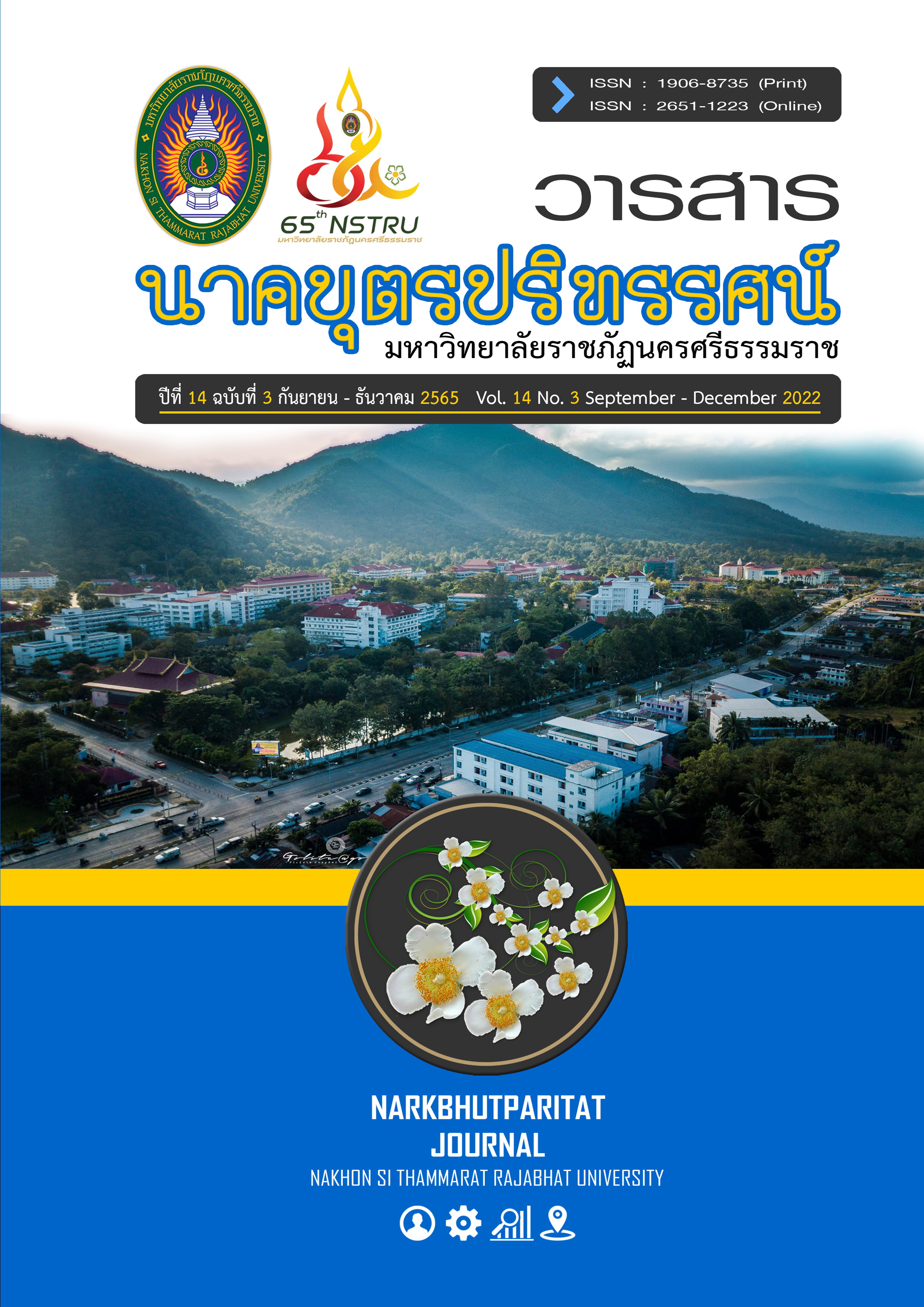The Effects of Innovativeness and Predecessor on Organizational Performance of Thai Herb Processing Entrepreneurs.
Main Article Content
Abstract
The research aimed to 1) investigate the effects of resource-based view on institutional-based view, innovativeness and organizational performance of Thai Herb Processing entrepreneurs, 2) find out the effects of institutional-based view on innovativeness and organizational performance of Thai Herb Processing entrepreneurs, and 3) investigate the effects of innovativeness on organizational performance of Thai Herb Processing entrepreneurs. The Research Methodology: mixed-method research methodology was employed in the study. The qualitative data collection method was in-depth interview. Six participants were interviewed by the researcher. The quantitative data was obtained from the questionnaire distributed to 403 employees working for the Thai Herb Processing Entrepreneurs. Techniques for Analyzing Structural Equation Modeling: SEM by Using Computer Program. The results showed that 1) resource-based view had positive effects on the institutional-based view but did not have directly effects on the innovativeness and organizational performance of Thai Herb Processing entrepreneurs; and 2) the institutional-based view had positive effects on innovativeness but did not have directly effects on organizational performance of Thai Herb Processing entrepreneurs; and 3) the innovativeness had positive effects on organizational performance of Thai herb Processing entrepreneurs. The new discovery and implication of the study: Resource-based view perspectives and institutional-based view perspectives influence innovativeness. They are important variables that affects the organizational performance of Thai herb processing entrepreneurs.
Article Details

This work is licensed under a Creative Commons Attribution-NonCommercial-NoDerivatives 4.0 International License.
References
Chimpalee, A. (2019). The Influence of Resource and Organization Based-Views and Organization Strategy on Real Estate Business Performance: A Case Study of Condominium Business in Bangkok. Kasem Bundit Journa,l 20(1), 38-47 (in Thai)
Awan, M. A. S., & Sarfraz, N. (2013). The impact of human capital on company performance and the mediating effect of employee’s satisfaction. Journal of Business and Management, 8(2), 76-82.
Barreto, I. (2010). Dynamic capabilities: A review of past research and an agenda for the future. Journal of Management, 36(2), 256–280.
Baum, J. A. C., & Oliver, C. (1991). Institutional linkages and organizational mortality. Administrative Science Quarterly, (36), 187-218.
Becker, B.E., & Huselid, M. A. (2006). Strategic human resources management: Where do we go from here? Journal of Management, (32), 898-925.
Chul H.U., Chang S.S. & Joo Y.P. (2018). Understanding the accelerator from resources-based perspective. Asia Pacific Journal of Innovation and Entrepreneurship, 12(3), 258-278.
Day, G. S., & Wensley, R. (1988). Assessing advantage: A framework for diagnosing competitive superiority. Journal of Marketing, (52), 1-20.
De los Reyes, G (2019). Institutional Entrepreneurship for Digital Public Health Promotion: Challenger and Opportunities. Health Education & Behavior, 46, 30-36.
Garcia, R., & Calantone, R. (2002). A critical look at technological innovation typology and innovativeness terminology: A literature review. Journal of Product Innovation Management, (19), 110–132.
Hult, G. T. M., & Ketchen, D. J., Jr. (2001). Does market orientation matter?: A test of the relationship between positional advantage and performance?. Strategic Management Journal, 22(9), 899-906.
Hunt, S. D., & Morgan, R. M. (1995). The comparative advantage theory of competition?. Journal of Marketing, (59), 1-15.
Hurley, Robert E. & G. Tomas M. Hult, (1998). Innovation, Market Orientation, and Organizational Learning: An Integration and Empirical Examination. Journal of Marketing 62(2),42-54.
Jaehun R., Taekyung P. & Do Hyung L. (2015). Drivers of innovativeness and performance for innovation SMEs in South Korea: Mediation of Learning orientation.
Juliana M.N., Vincent B., Evans A. & Zachary B.A. (2017). Strategic Planning Systems and Firm Performance in the Export Processing Zones. American journal of Industrial and Business Management, 7(2), 487-500.
McDougall, N., Wagner, B., & MacBryde, J. (2019). An empirical explanation of the natural-resource-based view of the firm. Production Planning & Control, 30, 1366-1382.
Min-Seong K. & Dong-Woo K. (2017). Linking LMX, engagement, innovative behavior, and job performance in hotel employees. International Journal of Contemporary Hospitality Management. International Journal of Contemporary Hospitality Management Vol. 29 No. 12, pp. 3044-3062.
Neely, A. D., Adams, C., & Kennerley, M. (2002). Performance prism: The scorecard for measuring and managing stakeholder relationships. New York: Prentice Hall.Oliver, C. (1991). Strategic responses to institutional processes. Academy of Management Review, 16, 145-179.
Powell, T. C., & Dent-Micallef, A. (1997). Information technology as competitive advantage: The role of human, business and technology resources. Strategic Management Journal, 18(2), 375-405.
Reinganum. J.F., (198l). Dynamic games of innovation. .Jmrrml of‘ Ecormnic~Throw. 25(3) 21-41.
Reinganum, J.F., (1982). A dynamic game of R&D: Patent protection and competitive behavior. Econotnrtncu, SO(3).671-688.
Ruzevicius, J., Klimas. D., & Veleckaite, R. (2012). Influence of organizational culture on the success of business process management in Lithuanian public sector organizations. 7(1), 1-16.
Sookyuen T. (2014). A Theoretical Model of the Organizational Performance of Social Enterprises: Combining the Resource Dependence and Resource-Based Views. Thai Journal of Public Administration, 12(2), 38-44
Suliyanto, S., & Rahab, R. (2012). The role of market. orientation and learning orientation In improving innovativeness and performance of small and medium
Teece, D. J. (2018). Business models and dynamic capabilities. Long range planning, 51(1), 40-49.
Williamson, O. E. (1991). Strategizing, economizing, and economic organization. Strategic Management Journal, 12(2), 75-94.
Yang Yang & Alison M. Konrad. (2011). Understanding Diversity Management Practices: Implications of Institutional Theory and Resource-Based Theory. Group & Organization Management, 36(1), 6-38.
Zehir, C., Can, E., & Karaboga, T. (2015). Linking entrepreneurial to firm performance: The role of differentiation strategy and innovation performance. Procedia-Social and Behavioral Sciences, 210, 358-367.
Zukin, S., & DiMaggio, P. J. (1990). Introduction. In S. Zukin & P. J. DiMaggio (Eds.), Structures of capital: The social organization of the economy (pp. 1-56). Cambridge, England: Cambridge University .


